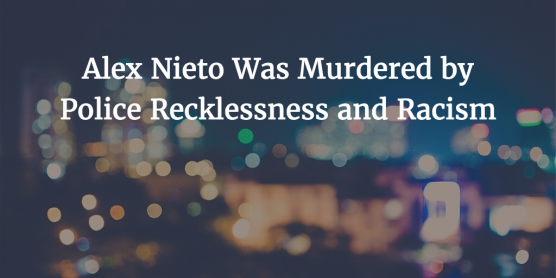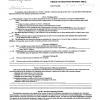This letter is a rebuttal to Joe Eskenazi’s 3/23/16 article, “Alex Nieto Was Not Killed by Gentrification – It’s Worse Than That,” his reaction to Rebecca Solnit’s 3/21/16 Guardian article on the Nieto case, “Death by Gentrification – the Killing that Shamed San Francisco.” Eskenazi’s armchair analysis of Alex Nieto’s mental health is off base, patronizing, and completely in lockstep with the District Attorney/SFPD media blitz undermining Alex Nieto’s credibility from Day #1. Most objectionable, Eskenazi concludes that Alex died, not as a consequence of faulty police decisions and excessive use of force, but due to the failure of San Francisco’s mental health services. Eskenazi gives readers his irresponsible “ruling” based not on the preponderance of actual evidence presented at trial but on a preponderance of police and D.A. distortion. His commentary on both Solnit’s article and the Nieto case is appalling, illustrating a “whitewashing” of police brutality, denial of racial bias factors, and pure speculation based on previous mental health incidents deemed by the court to be entirely irrelevant.
Eskenazi calls out Rebecca Solnit for gratuitously omitting crucial mental health factors in the case where he, himself, completely omits key witness reports that both contradict his theory and refute police testimony. Instead, Eskenazi spins his analysis based entirely on unquestioned police narratives and Alex’s years-old health records. Eskenazi writes that just before Nieto’s fatal encounter with the police, “witnesses describe him as ‘turning around quickly’ and ‘rigid and erratic in his movements’...” Eskenazi makes no mention that Alex had just experienced a large and aggressive dog repeatedly hounding him for food while the dog’s owner (witness Evan Snow) stood 40 feet away distracted by a “jogger’s butt.” Trying several times to alert Snow to retrieve his dog, Alex jumped up onto the bench where he had been sitting and, to get Snow’s attention, showed him his Taser, but never used the device. Additional witnesses report seeing Alex with what appeared to be a firearm, but saw no activation of the Taser. Of special note, the witness who called 911 (Justin Fritz) reported seeing Alex wearing an apparent gun on his hip, but otherwise sitting quietly eating a burrito and chips. Witness Robin Bullard testified that minutes before the police shooting, he saw Alex sitting calmly eating, noting that he looked like a “normal guy,” not acting erratic or bizarre in any way. Shortly after this, witness Antonio Theodore saw Alex walking casually down the road, hands in his pockets. Forensic evidence revealed at trial describes a bone fragment found in Alex’s jacket pocket, corroborating this witness’s observation.
Rookie officer Richard Schiff testified that when he and Lieutenant Jason Sawyer arrived at Bernal Hill Park, they drove their squad car to within 90 feet of Alex as he walked down the road, “flung open [their] car doors” and stepped out immediately, guns loaded and directed at Alex. Schiff claimed that he ordered Alex to show his hands but instead Alex pulled out his Taser and aimed it at the officers. Witness Theodore, however, with a clear view of the scene, saw no Taser removal or activation from Alex and merely heard the officers shout “Stop,” with no other warnings. Officers further claimed that Alex drew the Taser on them (which at the time they presumed to be a gun) in a “threatening stance.” Schiff testified that Alex looked at him with “an angry look and raised cheekbones with a furrowed brow” – clearly a subjective distortion, as forensic evidence later revealed that Alex was wearing a cap and sunglasses at the time which would have obscured his eyes and face. One officer claimed in deposition that he saw a “muzzle flash” from Alex’s Taser, refuted later by a Taser International expert witness who explained that Tasers do not create muzzle flashes. Officer Nathan Chew, arriving with his partner soon after the shooting began, testified that he saw no red tracking light on Alex’s Taser as claimed by Officer Schiff.
Within seconds of their arrival, Schiff and Sawyer initiated their barrage of bullets at Alex. They testified that Alex withstood dozens of shots before falling to the ground in a “military tactical position,” still aiming his [alleged gun] at them. Photos of the crime scene show 59 casings from police bullets shot and the Taser turned off with its safety switch intact, indicating it had not been activated nor able to emit the red light Officers Schiff and Sawyer claimed they saw. Officer Morse testified that once Alex was dead and he looked over the crime scene, he saw no wires ejected from the Taser.
Eskenazi makes a strong argument that police all too often handle mentally ill suspects with prejudice and force rather than prudent intervention strategies. He writes that the officers should have reacted to Alex as a “man in crisis” acting irrationally, but never acknowledges his own ignorance of the case nor his stark bias in how he reached the conclusion that Alex was even having a mental health crisis. Eskenazi never questions the rationality or veracity of the police officers themselves. Of particular concern here is his assumption that the officers arrived on the scene with a rationally-considered plan of action. Both officer and expert witness testimony showed definitively that none of the four officers involved in Alex’s killing had discussed a strategy at any point leading up to their encounter with him. At trial, retired Los Angeles Deputy Sheriff, a police policy expert for the plaintiffs, iterated the critical importance of police assessing the situation “objectively” rather than “subjectively” when arriving on the scene. This would reasonably involve stopping at a large enough distance to observe the ‘suspicious’ person’s behavior and actions, assessing the scene with “time, distance and cover,” he said, followed by determining a plan of action. Neither of the initial two officers to arrive on the scene followed this protocol, instead immediately driving up on Alex, and leaping out of their squad car with guns directed at him, escalating the situation from the get-go. Indiscriminate shooting began within seconds of their arrival. Officers Nathan Chew and Roger Morse soon arrived and joined in the shooting spree right away. Tragically, horribly, Alex was soon dead, riddled with bullets.
To Rebecca Solnit’s thesis about the effect of gentrification in Alex Nieto’s murder, clashes between white newcomers and long-time Black and Brown residents have been reported throughout the Bay Area in recent years. Specific to the Nieto case, Officer Schiff testified that he had picked up a radio call reporting a “Hispanic male” carrying a gun and wearing a black cap and red jacket, which Schiff interpreted could mean the suspect was a Norteño gang member. Witness Evan Snow also testified that he thought Alex might be a gang member, and in their altercation over Snow’s dog, Snow called Alex a racial slur, indicating that he later told a friend he wished the incident had taken place in Florida where he could have legally shot Nieto, in accordance with the stand-your-ground law in that state. A jury comprised of predominantly white women from outside San Francisco exonerated the four officers who murdered Alex, their verdict declaring that the police had not used excessive force in the killing.
On the basis of old mental health records released by the SF District Attorney after Alex’s death in 2014, Eskenazi concludes that his killing was a result of police reaction in confronting a “man with an extensive mental health record” and obvious “erratic and bizarre behavior.” Where Eskenazi makes a valid point and good case for police overreaction in dealing with suspects with mental illness, he reaches his “diagnosis” of Alex not on actual evidence but by conjecture, extrapolating from old health records deemed irrelevant to the case, and pathologizing Alex’s alleged “irrational behavior” while failing entirely to question police rationality, assumptions, behavior, and actions that fateful night. Alex died in a hail of gunfire within seconds of police officers arriving at Bernal Hill Park where he had just finished sitting quietly eating dinner and watching the sunset. Officers Schiff (a two-month rookie) and Sawyer (a former vet) took no time to assess the scene and instead acted impulsively and violently, as did Officers Morse and Chew when they converged on the scene, All told, officers unloaded 59 rounds of lethal ammunition, including 15 shots into Alex’s face, temple, chest, shoulders and back. A nearly all-white jury rewarded them with a non-guilty verdict.
Alex Nieto is dead while police impunity lives on.
Marty Jaye
San Francisco, CA
[email protected]
















